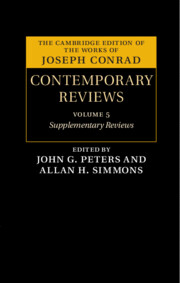118 results
Antibiotic prescribing patterns for bacterial superinfection of mpox: A retrospective cohort study in an urban center
-
- Journal:
- Antimicrobial Stewardship & Healthcare Epidemiology / Volume 3 / Issue 1 / 2023
- Published online by Cambridge University Press:
- 29 June 2023, e108
-
- Article
-
- You have access
- Open access
- HTML
- Export citation
Reviews Of Within The Tides
-
- Book:
- Joseph Conrad: Contemporary Reviews
- Published online:
- 22 March 2023
- Print publication:
- 26 January 2023, pp 424-443
-
- Chapter
- Export citation
Contents
-
- Book:
- Joseph Conrad: Contemporary Reviews
- Published online:
- 22 March 2023
- Print publication:
- 26 January 2023, pp vii-xlii
-
- Chapter
- Export citation
Reviews Of The Shadow–Line
-
- Book:
- Joseph Conrad: Contemporary Reviews
- Published online:
- 22 March 2023
- Print publication:
- 26 January 2023, pp 483-505
-
- Chapter
- Export citation
Reviews Of The Inheritors: An Extravagant Story, With Ford Madox Hueffer
-
- Book:
- Joseph Conrad: Contemporary Reviews
- Published online:
- 22 March 2023
- Print publication:
- 26 January 2023, pp 110-120
-
- Chapter
- Export citation
Introduction
-
- Book:
- Joseph Conrad: Contemporary Reviews
- Published online:
- 22 March 2023
- Print publication:
- 26 January 2023, pp 1-5
-
- Chapter
- Export citation

Joseph Conrad: Contemporary Reviews
-
- Published online:
- 22 March 2023
- Print publication:
- 26 January 2023
Reviews Of Lord Jim
-
- Book:
- Joseph Conrad: Contemporary Reviews
- Published online:
- 22 March 2023
- Print publication:
- 26 January 2023, pp 84-109
-
- Chapter
- Export citation
Reviews Of ‘twixt Land And Sea
-
- Book:
- Joseph Conrad: Contemporary Reviews
- Published online:
- 22 March 2023
- Print publication:
- 26 January 2023, pp 343-363
-
- Chapter
- Export citation
Reviews Of Tales Of Unrest
-
- Book:
- Joseph Conrad: Contemporary Reviews
- Published online:
- 22 March 2023
- Print publication:
- 26 January 2023, pp 62-83
-
- Chapter
- Export citation
Reviews Of Tales Of Hearsay
-
- Book:
- Joseph Conrad: Contemporary Reviews
- Published online:
- 22 March 2023
- Print publication:
- 26 January 2023, pp 705-732
-
- Chapter
- Export citation
Reviews Of The Secret Agent: A Simple Tale
-
- Book:
- Joseph Conrad: Contemporary Reviews
- Published online:
- 22 March 2023
- Print publication:
- 26 January 2023, pp 238-268
-
- Chapter
- Export citation
Reviews Of Under Western Eyes
-
- Book:
- Joseph Conrad: Contemporary Reviews
- Published online:
- 22 March 2023
- Print publication:
- 26 January 2023, pp 294-311
-
- Chapter
- Export citation
Reviews Of Falk, Amy Foster, To–Morrow: Three Stories
-
- Book:
- Joseph Conrad: Contemporary Reviews
- Published online:
- 22 March 2023
- Print publication:
- 26 January 2023, pp 170-180
-
- Chapter
- Export citation
Reviews Of The Rover
-
- Book:
- Joseph Conrad: Contemporary Reviews
- Published online:
- 22 March 2023
- Print publication:
- 26 January 2023, pp 633-688
-
- Chapter
- Export citation
Acknowledgments
-
- Book:
- Joseph Conrad: Contemporary Reviews
- Published online:
- 22 March 2023
- Print publication:
- 26 January 2023, pp xlvii-xlviii
-
- Chapter
- Export citation
Reviews Of Last Essays
-
- Book:
- Joseph Conrad: Contemporary Reviews
- Published online:
- 22 March 2023
- Print publication:
- 26 January 2023, pp 771-801
-
- Chapter
- Export citation
Reviews Of Typhoon And Other Stories
-
- Book:
- Joseph Conrad: Contemporary Reviews
- Published online:
- 22 March 2023
- Print publication:
- 26 January 2023, pp 149-169
-
- Chapter
- Export citation
Reviews Of Victory
-
- Book:
- Joseph Conrad: Contemporary Reviews
- Published online:
- 22 March 2023
- Print publication:
- 26 January 2023, pp 444-482
-
- Chapter
- Export citation
Reviews Of Romance, With Ford Madox Hueffer
-
- Book:
- Joseph Conrad: Contemporary Reviews
- Published online:
- 22 March 2023
- Print publication:
- 26 January 2023, pp 111-202
-
- Chapter
- Export citation



